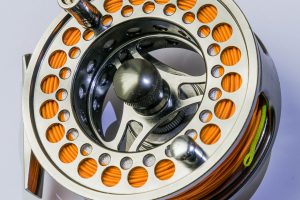The South American Pimelodus is a genus of catfish native to freshwater habitats in South America. These fish are commonly referred to as “Pimelodids,” belonging to the family Pimelodidae. They are characterized by their elongated bodies, barbels, and diverse range of sizes and appearances. Pimelodus species play a significant role in their native ecosystems and are also of interest to aquarists.

Species of Pimelodus exhibit a striking variety of behaviors and adaptations suited to their riverine environments. Many of these catfish are nocturnal, actively feeding and exploring at night. Their barbels help them locate food in the murky waters they often inhabit. Adaptability allows these species to thrive in various conditions, from fast-flowing streams to the still waters of lakes and ponds.
Research and conservation efforts are critical for the Pimelodus genus due to environmental challenges such as habitat loss and pollution. This genus’ role in the aquatic food web and its importance to local fisheries underscores the need to understand and protect these fish. Through scientific study, researchers hope to gain insights into the life cycles, behaviors, and ecological requirements of the Pimelodus to ensure their continuity in South America’s diverse freshwater systems.
Taxonomy and Classification
The genus Pimelodus, part of the Pimelodidae family, is a focal point for taxonomic discussion within the order Siluriformes due to its expansive species complex and intricate phylogenetic relationships.
Defining Pimelodus
Pimelodus refers to a genus of freshwater catfish primarily found in South America. It’s part of the family Pimelodidae, which belongs to the order Siluriformes. This genus includes several species characterized by their long barbels and diverse ecological roles within their native habitats.
Taxonomic History
The taxonomic review of Pimelodus has evolved over time, with phylogenetic analysis playing a crucial role in understanding its classification. Initial taxonomy was based on morphological traits but later supplemented by genetic studies. These analyses aimed at deciphering the phylogenetic relationships within the genus to establish a clear monophyletic lineage – a group of organisms descended from a common ancestor.
Genus Overview
Pimelodus represents a neotropical genus with many species exhibiting genetic similarities. It forms a species complex with overlapping morphological features challenging taxonomists. Recognition and description of distinct clades within Pimelodus are ongoing, emphasizing the genus’s diversity. Despite these complexities, taxonomic consensus currently places this genus within a well-defined family of catfish, illustrating a rich assembly of taxa with varied ecological significance.
Physical Characteristics

The South American Pimelodus exhibits distinctive physical features that aid in identification and morphological differentiation among fish species. These features include the presence of characteristic barbels and a pronounced adipose fin.
Morphological Traits
The Pimelodus species are characterized by their elongated bodies and flattened heads. They typically have a length that can range from moderate to fairly large size among freshwater fish. Their skin is devoid of scales, a trait called acyclicity.
- Head: Flattened ventrally with a broad, terminal mouth
- Teeth: Arranged in bands on both jaws
- Gill: Covering with spines
Distinguishing Features
For accurate identification, the South American Pimelodus possesses several distinguishing features that are paramount. These include barbels and adipose fins which are key to morphological differentiation.
- Barbels: One pair of maxillary and two pairs of mandibular barbels are present, aiding in sensory perception.
- Adipose Fin: Most species have a well-developed, non-rayed adipose fin, which is a small, fleshy fin located between the dorsal and caudal fins.
Distribution and Habitat
The South American Pimelodus is a freshwater fish primarily distributed across various river systems in South America. Its habitat encompasses rivers and streams with diverse ecological conditions.
Geographical Range
The Pimelodus species is widely distributed across South America, specifically in major river basins such as the Amazon River, Magdalena-Cauca River Basin, and the Rio Tocantins drainage. In the north-western region of South America, countries like Colombia serve as important locations for the species’ range.
- Amazon River: Significant population density throughout its length.
- Magdalena-Cauca River Basin: Presence in both upper and lower reaches.
- Rio Tocantins Drainage: Established communities within this system.
Ecological Niche
These fish occupy a unique ecological niche within the freshwater ichthyofauna of South America. They are adept at navigating the diverse habitats found in their distribution range, which includes:
- Slow-moving rivers and streams: Favoring muddy bottoms and sheltered areas.
- Varied water conditions: Able to adapt to various turbidity and oxygen levels.
Habitat characteristics such as temperature, water flow, and availability of food sources are crucial for the Pimelodus populations to thrive, confirming their role as a versatile component of their ecosystems.
Evolutionary Aspects
Pimelodus species in South America exhibit unique evolutionary traits. The South American Pimelodus has evolved through complex speciation and frequent hybridization events, as evidenced by molecular studies.
Phylogenetic Studies
Pimelodus is a group with diverse evolutionary history. Recent phylogenetic studies largely focus on molecular data, including mitochondrial DNA (mtDNA) and nuclear markers such as microsatellites and RADseq, to unravel the relationships within this genus. Analysis of the mitochondrial cox1 gene has been instrumental in identifying haplotypes and molecular delimitations of distinct species. Results from these studies indicate that speciation in Pimelodus is often due to geographical isolation, such as the uplift of the Northern Andes and the formation of the Altiplano Antioqueño, which altered river drainages, creating barriers for gene flow.
- Genomic data from various species including Pimelodus punctatus, Pimelodus yuma, and Pimelodus grosskopfii have provided insights into the species limits and evolutionary relationships.
- mtDNA analyses have played a key role in the understanding of the genetic diversity and partitioning among populations.
Speciation and Hybridisation
The processes of speciation and hybridization are pivotal in the diversification of Pimelodus species. The discovery of cryptic species through the use of both single-locus and multi-locus approaches has been a testament to the complex evolutionary patterns in this group.
- Introgression, particularly genetic introgression, has been well-documented between Pimelodus species, such as Pimelodus grosskopfii and its closely related counterparts.
- Hybrid zones are prevalent, with occurrences of both historical and recent introgression events, often revealed through allele-frequency methods.
Studies suggest that species like Pseudoplatystoma corruscans have hybridized with Pimelodus species, complicating species delimitation. These events can lead to the emergence of new haplotypes, influencing allele frequency and the potential birth of new species that are reproductively isolated from their parent species. Researchers employ DNA extraction techniques to obtain genetic material, further utilizing single-nucleotide polymorphisms (SNPs) to define species boundaries and understand the speciation processes.
Ecology and Behavior
The South American Pimelodus species, including Pimelodus coprophagus, Pimelodus navarroi, and Pimelodus crypticus, display distinct ecological roles and behavioral patterns in their aquatic habitats. Biological studies have provided insights into their adaptations for survival.
Feeding Habits
Pimelodus coprophagus is known for its unique feeding strategy, where it feeds on the feces of other fish, a trait that is reflected in its species name, meaning “dung-eating.” This unusual diet places it in a specialized niche within river ecosystems and influences the gene flow within the species by affecting its habitat choice and migration patterns.
Pimelodus navarroi, on the other hand, consumes a broader range of substrates. It is a scavenger species, often found at the bottom of water columns in search of detritus and smaller organisms that form its diet.
Pimelodus crypticus has a similarly varied diet, and while there is less specific information on its feeding habits, it is thought to share many characteristics with closely related species.
Feeding habits of these fish are critical for understanding their role in the ecosystem and their interspecies relationships, directly affecting their survival and reproductive success.
Reproduction and Life Cycle
The reproductive behavior of Pimelodus species plays a vital role in maintaining their populations. Pimelodus coprophagus exhibits seasonal breeding patterns, with reproductive activity peaking during times when water levels are high, which likely spreads their offspring across a wider area, reducing competition and increasing chances of survival.
Pimelodus navarroi is understood to have similar reproductive strategies, where the timing of spawning may be influenced by water conditions, such as temperature and flow, all critical factors in their life cycle. These environmental cues ensure that their young have optimal conditions for growth upon hatching.
Pimelodus crypticus is less studied, but based on information from congeneric species, it is likely to have reproductive cycles aligned with the seasonal dynamics of its environment.
Understanding the reproductive strategies and life cycles of Pimelodus species can help in the conservation and management of these important ecological contributors, ensuring their continued presence in South American aquatic systems.
Conservation and Threats
The conservation of the South American Pimelodus is a complex issue involving a number of threats and corresponding efforts to manage and mitigate them. This section provides a focused analysis of the conservation status, environmental challenges, and current actions aimed at preserving this species.
Conservation Status
Species within the genus Pimelodus vary in their conservation status. However, due to insufficient biodiversity assessments, many are not well classified on the IUCN Red List. The biological species concept informs evaluations, yet a lack of comprehensive data often hampers precise categorization. Consequently, conservation status might be undetermined or vary locally.
Environmental Threats
Several environmental threats impact Pimelodus populations:
- Habitat Destruction: Deforestation and pollution degrade the ecosystems where these fish reside.
- Hybridisation: Especially concerning is the hybridisation with non-native species. It poses genetic risks that might erode the genetic integrity of Pimelodus, affecting their versatility and survival.
- Climate Change: Altered water temperatures and flow patterns can disrupt life cycles.
- Overfishing: It remains a persistent threat affecting population numbers.
Conservation Efforts
Efforts to protect Pimelodus include:
- Legal Protections: Implementation of local and international regulations to control fishing practices and prevent illegal trade.
- Habitat Restoration: Initiatives to restore and preserve aquatic environments.
- Research: Focus on genetics studies, such as RAG2 gene analysis, to understand the effects of hybridisation and assist in their conservation.
- Community Engagement: Educating local communities about sustainable fishing and the importance of the species within the ecosystem can help foster protection.
Economic and Cultural Significance
The South American Pimelodus, a species of catfish, possesses notable economic and cultural value. These fish contribute to regional aquaculture and fisheries, and hold important symbolic roles within certain communities.
Aquaculture and Fisheries
South American catfish, including the Pimelodus species, are integral to local fisheries and are increasingly important in the aquaculture industry. Economic reliance on these species is significant due to their popularity as a food source. In terms of aquaculture, the Pimelodus catfish are cultivated for several reasons:
- They adapt well to farm conditions, which makes them viable for aquaculture.
- Wild stocks of Pimelodus may face overfishing; aquaculture offers an alternative that can alleviate pressure on wild populations.
The growth of this industry is bolstered by advancements in farming technology and practices that enable higher yields and healthier stock.
Symbolic Importance
The Pimelodus species sometimes carry cultural and symbolic importance in South American societies. They are not just seen as a commodity, but as a species interwoven with tradition and community practices. Details on this symbolic importance include:
- Representation of the Pimelodus in local folklore and spirituality.
- Use in traditional cuisine, which reinforces their cultural significance.
Their presence in cultural narratives underscores their value beyond mere economic terms.
Research and Scientific Studies
Research on the South American Pimelodus has been gaining prominence, particularly in genetics and ecology. There is a critical emphasis on understanding the genetic makeup and biodiversity of these species to aid in their conservation.
Advances in Genetic Research
Scientists have utilized molecular markers and polymerase chain reaction-restriction fragment length polymorphism (PCR-RFLP) techniques to study the genetic diversity and structure of Pimelodus populations. Notably, Pimelodus maculatus, a widely distributed species in the water bodies of South America, has been extensively analyzed. GenBank, a genetic sequence database, has been essential in this aspect, storing a multitude of sequences from various Pimelodus species for comparison and study. Recent findings suggest some level of genetic introgression between Pimelodus maculatus and related taxa in overlapping habitats, indicating that they are not completely reproductively isolated.
Ecological and Conservation Research
Research in this area primarily focuses on the habitat and distribution of Pimelodus species across different river basins such as the Paraná River Basin and the São Francisco River Basin. Efforts to conserve these catfishes involve understanding their role within the ecosystem (Peixes Project) and the effects of environmental changes on their populations. Subfamilies like Propimelodus and Pseudopimelodidae provide insight into the ecosystem’s health, as their presence and diversity can indicate water quality and biodiversity. Conservation studies often involve mapping the species distribution using ecological data and assessing the impacts of human-induced changes on their habitats.











